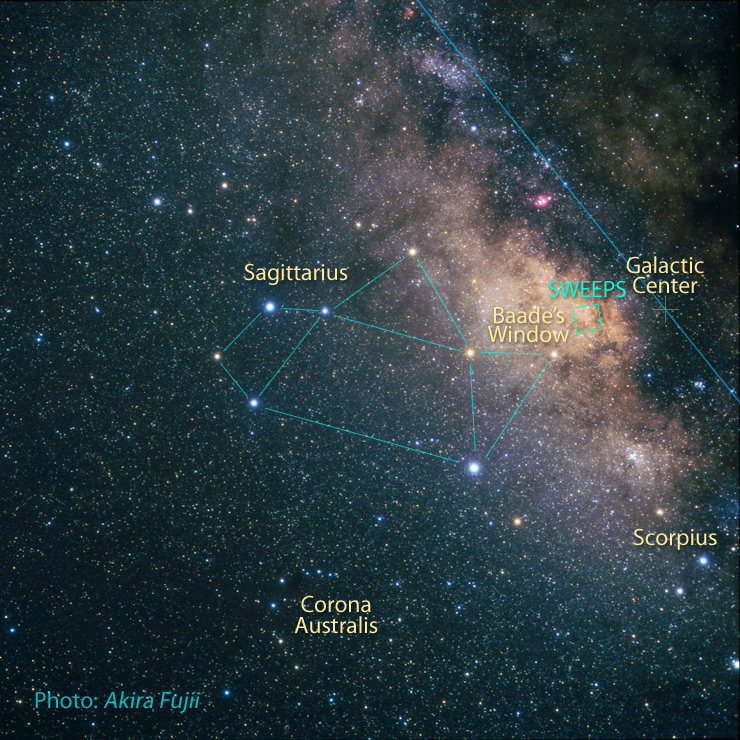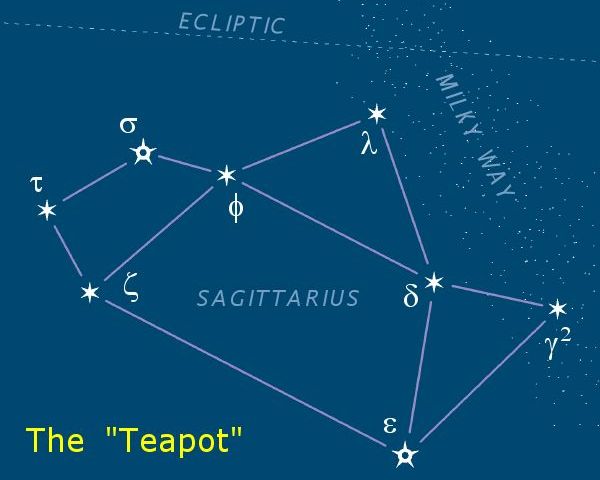|
SWEEPS-10
, - style="vertical-align: top;" SWEEPS-10 is an extrasolar planet that, from June 2007 to August 2011, was the planet candidate with the shortest orbital period yet found, until PSR J1719-1438 b was discovered in 2011 with an even shorter orbit. The planet orbits the star SWEEPS J175902.00−291323.7 located in the Galactic bulge at a distance of approximately 22,000 light years from Earth (based on a distance modulus of 14.1). It completes an orbit of its star (designated SWEEPS J175902.00−291323.7) in just 10 hours, and is categorized as an ultra-short period planet (USPP). Located only 1.2 million kilometers from its star (roughly three times the distance between the Earth and the Moon), the planet is among the hottest ever detected; its estimated temperature is approximately 1,650 degrees Celsius. "This star-hugging planet must be at least 1.6 times the mass of Jupiter, otherwise the star's gravitational muscle would pull the planet apart," said team leader Kailash Sa ... [...More Info...] [...Related Items...] OR: [Wikipedia] [Google] [Baidu] |
Sagittarius Window Eclipsing Extrasolar Planet Search
The Sagittarius Window Eclipsing Extrasolar Planet Search, or SWEEPS, was a 2006 astronomical survey project using the Hubble Space Telescope's Advanced Camera for Surveys#Wide Field Channel .28WFC.29, Advanced Camera for Surveys - Wide Field Channel to monitor 180,000 stars for seven days to detect extrasolar planets via the transit method. Area examined The stars that were monitored in this astronomical survey were all located in the Sagittarius-I Window. The Sagittarius Window is a rare view to the Milky Way's Galaxy bulge#Galactic bulge, central bulge stars: our view to most of the galaxy's central stars is generally blocked by Dark nebula, lanes of dust. These stars in the galaxy's central bulge region are approximately 27,000 light years from Earth. Planets discovered Sixteen candidate planets were discovered with orbital periods ranging from 0.6 to 4.2 days. Planets with orbital periods less than 1.2 days have not previously been detected, and have been dubbed "ultra-s ... [...More Info...] [...Related Items...] OR: [Wikipedia] [Google] [Baidu] |
SWEEPS-04
SWEEPS-04 is an extrasolar planet orbiting the star SWEEPS J175853.92−291120.6 in the constellation Sagittarius approximately 27,710 light years away (based on a distance modulus of 14.1) from the Solar System, making it (along with SWEEPS-11) the most distant exoplanet(s) known. This planet was found in 2006 by the Sagittarius Window Eclipsing Extrasolar Planet Search (SWEEPS) program that uses the transit method. The upper limit on the planet's mass is 3.8 times the mass of Jupiter. The best fit radius is 0.81 times that of Jupiter, but the uncertainty in this value is large, around 12%. It orbits at an average distance of 8,200,000 km (0.055 AU) from the parent star, taking 4.2 days to revolve around it. fILE:HST SWEEPS-4 2006.jpg, HST SWEEPS-4 2006 File:Radial Velocities of SWEEPS-04 (UVES-VLT).jpg, Radial Velocities of SWEEPS-04 (UVES-VLT) File:Artist's impression of a transiting Jupiter-mass exoplanet SWEEPS J175853.92-291120.6 b.jpg, Artist's impression of a trans ... [...More Info...] [...Related Items...] OR: [Wikipedia] [Google] [Baidu] |
SWEEPS-11
SWEEPS-11 is an extrasolar planet orbiting SWEEPS J175902.67−291153.5 in the constellation Sagittarius, approximately 27,710 light years away from the Solar System (based on a distance modulus of 14.1), making it (along with SWEEPS-04) the most distant exoplanet(s) known. This planet was found in 2006 by the Sagittarius Window Eclipsing Extrasolar Planet Search (SWEEPS) program that uses the transit method. This hot Jupiter has a mass 9.7 times that of Jupiter and a radius of 1.13 times that of Jupiter, but the uncertainty in this value is large, around 21%. The planet orbits at about 1.75 times closer to the star than 51 Pegasi b is to 51 Pegasi, taking only 1.8 days or 43 hours to orbit the star. It is also the most distant planet yet discovered. See also * SWEEPS-04 * SWEEPS-10 , - style="vertical-align: top;" SWEEPS-10 is an extrasolar planet that, from June 2007 to August 2011, was the planet candidate with the shortest orbital period yet found, until PSR J1719-1 ... [...More Info...] [...Related Items...] OR: [Wikipedia] [Google] [Baidu] |
Sagittarius (constellation)
Sagittarius is one of the constellations of the zodiac and is located in the Southern celestial hemisphere. It is one of the 48 constellations listed by the 2nd-century astronomer Ptolemy and remains one of the 88 modern constellations. Its old astronomical symbol is (♐︎). Its name is Latin for "archery, archer". Sagittarius is commonly represented as a centaur drawing a bow. It lies between Scorpius and Ophiuchus to the west and Capricornus and Microscopium to the east. The center of the Milky Way lies in the westernmost part of Sagittarius (see Sagittarius A). Visualizations As seen from the northern hemisphere, the constellation's brighter stars form an easily recognizable asterism (astronomy), asterism known as "the Teapot". The stars Delta Sagittarii, δ Sgr (Kaus Media), Epsilon Sagittarii, ε Sgr (Kaus Australis), Zeta Sagittarii, ζ Sgr (Ascella), and Phi Sagittarii, φ Sgr form the body of the pot; Lambda Sagittarii, λ Sgr (Kaus Borealis) is the point of t ... [...More Info...] [...Related Items...] OR: [Wikipedia] [Google] [Baidu] |
Jupiter
Jupiter is the fifth planet from the Sun and the List of Solar System objects by size, largest in the Solar System. It is a gas giant with a Jupiter mass, mass more than 2.5 times that of all the other planets in the Solar System combined and slightly less than one-thousandth the mass of the Sun. Its diameter is 11 times that of Earth and a tenth that of the Sun. Jupiter orbits the Sun at a distance of , with an orbital period of . It is the List of brightest natural objects in the sky, third-brightest natural object in the Earth's night sky, after the Moon and Venus, and has been observed since prehistoric times. Its name derives from that of Jupiter (god), Jupiter, the chief deity of ancient Roman religion. Jupiter was the first of the Sun's planets to form, and its inward migration during the primordial phase of the Solar System affected much of the formation history of the other planets. Jupiter's atmosphere consists of 76% hydrogen and 24% helium by mass, with a denser ... [...More Info...] [...Related Items...] OR: [Wikipedia] [Google] [Baidu] |
Giant Planets
A giant planet, sometimes referred to as a jovian planet (''Jove'' being another name for the Roman god Jupiter), is a diverse type of planet much larger than Earth. Giant planets are usually primarily composed of low-boiling point materials ( volatiles), rather than rock or other solid matter, but massive solid planets can also exist. There are four such planets in the Solar System: Jupiter, Saturn, Uranus, and Neptune. Many extrasolar giant planets have been identified. Giant planets are sometimes known as gas giants, but many astronomers now apply the term only to Jupiter and Saturn, classifying Uranus and Neptune, which have different compositions, as ice giants. Both names are potentially misleading; the Solar System's giant planets all consist primarily of fluids above their critical points, where distinct gas and liquid phases do not exist. Jupiter and Saturn are principally made of hydrogen and helium, whilst Uranus and Neptune consist of water, ammonia, and methane. ... [...More Info...] [...Related Items...] OR: [Wikipedia] [Google] [Baidu] |
Hot Jupiters
Hot Jupiters (sometimes called hot Saturns) are a class of gas giant exoplanets that are inferred to be physically similar to Jupiter (i.e. Jupiter analogues) but that have very short orbital periods (). The close proximity to their stars and high surface-atmosphere temperatures resulted in their informal name "hot Jupiters". Hot Jupiters are the easiest extrasolar planets to detect via the radial-velocity method, because the oscillations they induce in their parent stars' motion are relatively large and rapid compared to those of other known types of planets. One of the best-known hot Jupiters is . Discovered in 1995, it was the first extrasolar planet found orbiting a Sun-like star. has an orbital period of about four days. General characteristics Though there is diversity among hot Jupiters, they do share some common properties. * Their defining characteristics are their large masses and short orbital periods, spanning 0.36–11.8 Jupiter masses and 1.3–111 ... [...More Info...] [...Related Items...] OR: [Wikipedia] [Google] [Baidu] |
Exoplanet Candidates
An exoplanet or extrasolar planet is a planet outside the Solar System. The first confirmed detection of an exoplanet was in 1992 around a pulsar, and the first detection around a main-sequence star was in 1995. A different planet, first detected in 1988, was confirmed in 2003. In 2016, it was recognized that the first possible evidence of an exoplanet had been noted in 1917. In collaboration with ground-based and other space-based observatories the James Webb Space Telescope (JWST) is expected to give more insight into exoplanet traits, such as their composition, environmental conditions, and potential for life. There are many methods of detecting exoplanets. Transit photometry and Doppler spectroscopy have found the most, but these methods suffer from a clear observational bias favoring the detection of planets near the star; thus, 85% of the exoplanets detected are inside the tidal locking zone. In several cases, multiple planets have been observed around a star. About 1 ... [...More Info...] [...Related Items...] OR: [Wikipedia] [Google] [Baidu] |
Nature (journal)
''Nature'' is a British weekly scientific journal founded and based in London, England. As a multidisciplinary publication, ''Nature'' features Peer review, peer-reviewed research from a variety of academic disciplines, mainly in science and technology. It has core editorial offices across the United States, continental Europe, and Asia under the international scientific publishing company Springer Nature. ''Nature'' was one of the world's most cited scientific journals by the Science Edition of the 2022 ''Journal Citation Reports'' (with an ascribed impact factor of 50.5), making it one of the world's most-read and most prestigious academic journals. , it claimed an online readership of about three million unique readers per month. Founded in the autumn of 1869, ''Nature'' was first circulated by Norman Lockyer and Alexander MacMillan (publisher), Alexander MacMillan as a public forum for scientific innovations. The mid-20th century facilitated an editorial expansion for the j ... [...More Info...] [...Related Items...] OR: [Wikipedia] [Google] [Baidu] |
Red Dwarf
A red dwarf is the smallest kind of star on the main sequence. Red dwarfs are by far the most common type of fusing star in the Milky Way, at least in the neighborhood of the Sun. However, due to their low luminosity, individual red dwarfs are not easily observed. Not one star that fits the stricter definitions of a red dwarf is visible to the naked eye. Proxima Centauri, the star nearest to the Sun, is a red dwarf, as are fifty of the sixty nearest stars. According to some estimates, red dwarfs make up three-quarters of the fusing stars in the Milky Way. The coolest red dwarfs near the Sun have a surface temperature of about and the smallest have radii about 9% that of the Sun, with masses about 7.5% that of the Sun. These red dwarfs have spectral types of L0 to L2. There is some overlap with the properties of brown dwarfs, since the most massive brown dwarfs at lower metallicity can be as hot as and have late M spectral types. Definitions and usage of the term "red d ... [...More Info...] [...Related Items...] OR: [Wikipedia] [Google] [Baidu] |
Baltimore, Maryland
Baltimore is the List of municipalities in Maryland, most populous city in the U.S. state of Maryland. With a population of 585,708 at the 2020 United States census, 2020 census and estimated at 568,271 in 2024, it is the List of United States cities by population, 30th-most populous U.S. city. The Baltimore metropolitan area is the Metropolitan statistical areas, 20th-largest metropolitan area in the country at 2.84 million residents. The city is also part of the Washington–Baltimore combined statistical area, which had a population of 9.97 million in 2020. Baltimore was designated as an Independent city (United States), independent city by the Constitution of Maryland in 1851. Though not located under the jurisdiction of any county in the state, it forms part of the central Maryland region together with Baltimore County, Maryland, the surrounding county that shares its name. The land that is present-day Baltimore was used as hunting ground by Paleo-Indians. In the early 160 ... [...More Info...] [...Related Items...] OR: [Wikipedia] [Google] [Baidu] |








